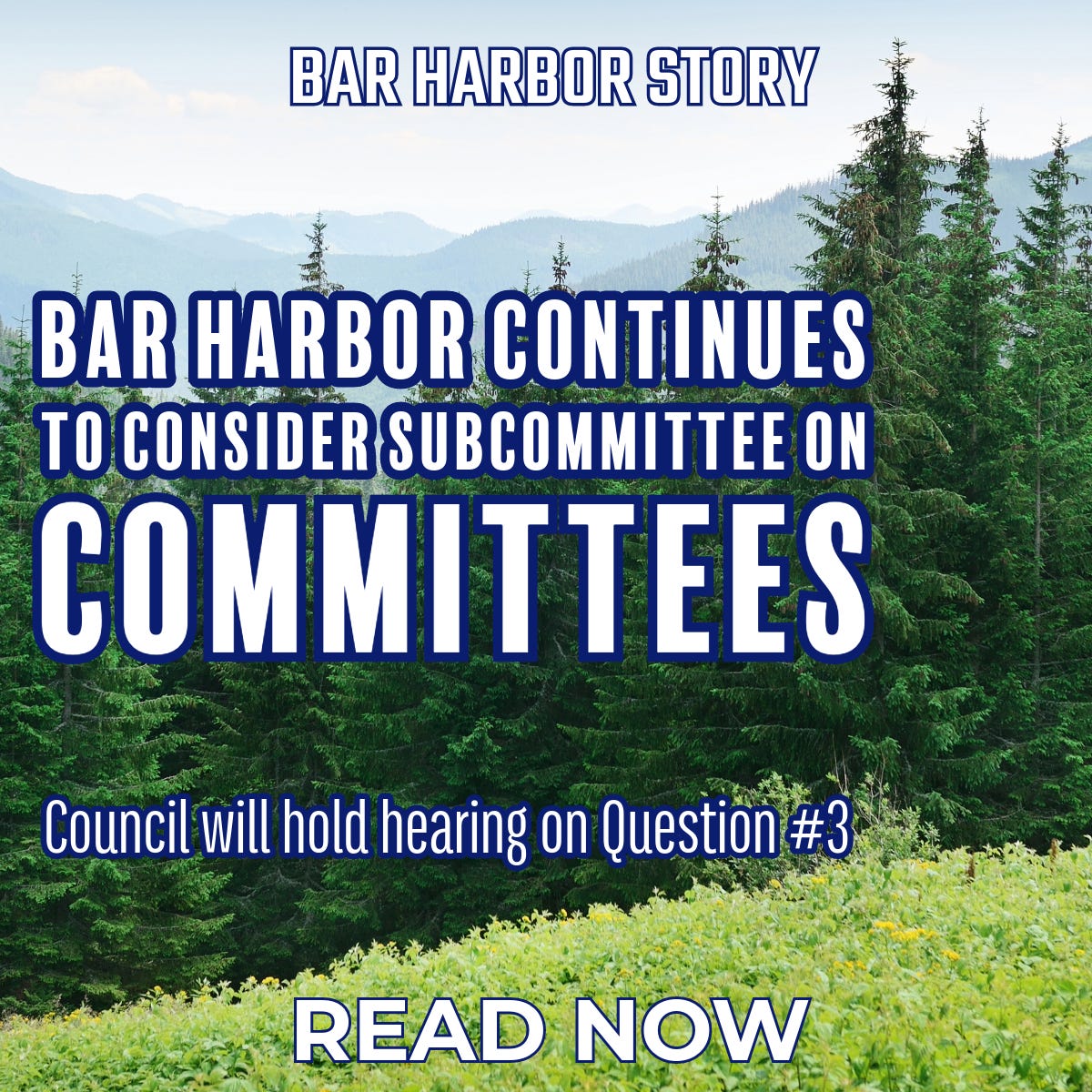Bar Harbor Continues to Consider Subcommittee on Committees
Council will hold hearing on Question #3
BAR HARBOR—The Bar Harbor Town Council decided during its Tuesday meeting to continue forward and create a working group or subcommittee about the town’s committees.
Approximately five years ago, there was a review of committees. Currently, the Age Friendly Committee has asked to disband because of a lack of quorum and connection to the council. Other board members have said similar things about lack of connection. There has also been a suggestion for a new committee on tourism management or sustainability. The Cruise Ship Committee was officially disbanded at the council meeting two weeks ago.
A review, Council Chair Val Peacock said, would involve talking to board chairs and those who staff the meetings.
Councilor Maya Caines said she spoke to a current committee member and they said people don’t show up to committee meetings because people feel as if the work doesn’t matter. She said it’s important to engage the chairs of the committees, but it’s also important to talk to committee members. “We want more people to be engaged.” She also said she doesn’t want the same five people to be on committees.
Committee, board, and task force members are first interviewed by the Appointments Committee, made up of three councilors. Then they must be approved by a majority of councilors during a Town Council meeting.
Peacock said that when creating the group to discuss committees, they should have only two councilors meet, which would mean that the town does not have to make a public notice of the meeting. She stressed that this would allow them to “do deep work” and “not to make it secret” she said, but to make it easier. She thought that Town Clerk Liz Graves should also be on the committee.
A review of the town’s ethics ordinance will also occur in the beginning of December and that conversation can inform the subcommittee, Peacock said.
Councilor Matt Hochman and former councilor Erin Cough worked on committee structures and intents five years ago. He said he’d happily do it again. He added that the council has a haphazard approach to what committees have council liaisons and which don’t and that those liaisons for the major committees might help make committee members feel as if their recommendations and work is being heard. The committee handbook that was created doesn’t get dispersed to new committee members, he said. That original document, he believed, started with former councilors Paul Paradis and Ruth Eveland.
Eveland later said in committee comments that the handbook was meant as a recruiting tool to help get people to volunteer for town committees and boards.
Vice Chair Gary Friedmann said he wasn’t supportive of creating a subcommittee or working group and that he’d rather look at just the committees where the chairs think that there is a problem. Most committees have charters or statutes that govern them, he said, and because of that making changes is difficult, especially given the council’s workload. He’d rather spend time on substantive issues, of which they have many. He said, “We have a housing crisis. We have comp plan issues. We have budget issues. We have a whole host of issues.”
Peacock said that councilors need committees to help the council and give them recommendations. “I think there’s things we can do as a council and as a collective body of government to work together better.” She said there’s some disconnections occurring, including who is looking at what in the town.
Making committees more functional and giving them more agency and connections with the council were the questions Hochman would like addressed even as they look at larger issues such as housing, tourism, and transportation.
“We can’t lose sight of the small things that keep our town working,” he said.
In public comment, Charles Sidman said that he thought the council was on the right track when focusing on the missions of the committees and tying it to the ethics ordinance, which he said stipulates that the council can be liaisons but not voting members of committees.
Eveland and Ezra Sassaman both said that the value of a committee is to extend the volunteer base as well as act as a feeder role for the council. Eveland feels former committee members tend to be better councilors because they understand how town governance works.
Sassaman said he also thought that bodies like the task force were great places for students to be engaged in the town.
Caines asked how much of the work could they put on individual committees to report what they need.
Sidman advised calling it a working group of the council rather than a subcommittee because “committee” implies community involvement.
The creation of a working group or subcommittee will be put on the next council agenda.
The Town Council quickly
Appointed Town Clerk Liz Graves as the election warden;
Approved the 2023 Emergency Operations Plan;
Accepted a $200,000 grant from the Federal Highway Administration that will hire a consultant “to prepare a safety action plan for Bar Harbor in the Village area and up Route 3, but will have a cursory review through the corridor to Ellsworth;”
Approved the Chamber of Commerce’s request for a buoy tree fundraiser at Harborview Park;
Amended the town’s personnel rules so that they comply with federal law;
Approved a special amusement permit for the Thirsty Whale;
Approved a utility pole in a parking lot on Bridge Street.
EMERGENCY OPERATIONS PLAN
The Emergency Operations Plan is approved annually by the council. Councilor Kyle Shank asked about references for a public information officer, which is a position that doesn’t exist in the budget. A communications officer is mentioned, he said. That role does not currently exist nor is it filled.
Fire Chief Matt Bartlett said that Graves, as town clerk, currently serves as a public information officer. Caines was the communications coordinator before being let go this winter. The position had been defunded and replaced in the budget by a $30,000 potential expenditure for communications needs.
COMPREHENSIVE PLAN UPDATE
Councilors received a quick update on the 2035 Comprehensive Plan.
Caines asked how long they anticipate writing the plan. Steve Whitman, the lead consultant on the plan, said that he thinks it’ll take a couple months to get it all together and formatted.
Town Planner Michele Gagnon said the “Existing Conditions Analysis” has been written, which she described as a backup document to inform where the town is at, stressing that the upcoming comprehensive plan is going to look different than what people are used to.
The plan and action plan for land use will be written around themes.
“We don’t want to just live in the past. We want to live in the future. We want to be respectful of the past,” Gagnon said, which is why the Comprehensive Planning Committee and town staff have gone through the existing plan with boards and committees to see what is still applicable or not.
Shank said that so many public feedback sessions occurred that created a lot of nuanced information to sort through and put into the plan and that aspects of that feedback and themes in the plan touch on other aspects. Getting it right, he said, is more important to him than taking a long time.
Sidman said during public comment that a lot of it sounded like flags, motherhood, and apple pie that nobody could argue with. He suggested talking about how change can create results and showing what people favor vs what they don’t favor.
Eveland said that the last comprehensive plan was a series of Post-Its, where everyone put their wishes on it, which was one of the reasons the plan itself was confusing and contradictory.
“The last one just made everyone’s head spin,” she said.
This time, she believes, they will have a more consistent and coherent document that stemmed from conceptualization.
JACKSON LAB UPDATE
At the beginning of the update, Hochman disclosed that he works at but not for the lab and that his wife works for the lab.
The lab’s Director of Government and Community Relations, Mike McKernan, who is also a Comprehensive Planning Committee member said that there are 410 employees who live in Bar Harbor. The rest commute. Some of those commuters use the Island Explorer which has five different routes. He said the utilization of that service has increased.
The lab pays about $800,000 in water and wastewater fees to the town for the infrastructure it uses. Water supply and wastewater fees do not benefit the town’s budget in the same way as property tax or parking meters. Those fees are used for the maintenance and improvement of existing infrastructure and do not benefit the overall town budget. As reported by the Bar Harbor Story in July, the lab is the single biggest user of town water.
The lab expects its property tax payment to double next year because it purchased a residential property and it will have a larger assessed value for its now completed workforce housing, which hadn’t been fully assessed previously because it was still under construction. The lab’s property tax last year was about $75k. McKernan said the lab has supported the YMCA, Jesup Memorial Library, and Kids Corner.
There are about 75 students and employees that the lab houses. McKernan said the lab hasn’t tried to measure employee satisfaction with commuting. Gagnon said that the town has done targeted surveys of employees who did not live in Bar Harbor but worked here.
In the next several years, the lab is going to be investing its capital in research development and structure not in housing, but it has the ability to build more at its current housing sites.
Currently, the lab is building a daycare that will serve up to 53 children. The daycare will be staffed and run by the Downeast Family YMCA which is based in Ellsworth. The daycare is on the south side of the campus as it borders Acadia National Park. It will open in early 2024.
The parking lot B entrance relocation project is part of a multi-year program trying to add safety to pedestrians and motorists traveling in front of the lab’s property on Route 3. This is in a highly visible new location slightly to the north of the campus and closer to Bar Harbor’s downtown.
“Traffic safety at that crossing was really brought into clear view” when an employee died, McKernan said. There have been other near misses. Moving the parking lot entrance increases sightlines for motorists and makes where pedestrians cross less congested.
“It’s a large project, but we think it will be a really important component” to the lab’s safety program, he said.
The lab’s payment in lieu of taxes (PILOT) that’s paid to the town is approximately $77 per employee, Shank said, adding that might be an interesting way to look at what PILOTS are paid by nonprofits throughout town.
JAX’s voluntary contribution to the Town of Bar Harbor in FY 2022 was $115,781, not 410 X $77 at $31,570, which would be the amount per local employee.
PINE TREE POWER
Climate Change Task Force member Ezra Sassaman presented a letter asking the council to publicly endorse question #3. Part of the need, he said is because of Versant, the current electricity supplier, is often delaying solar connections to the Maine energy grid and/or not providing information and data needed for projects, including those for the town’s Higgins Pit project.
Friedmann recused himself from the discussion because he’s a member of the board of Pine Tree Power.
Shank said he supported Bar Harbor supporting this. He said the energy grid in Maine is terrible and the state isn’t going to build pipelines or restart Yankee. The state votes down ways to increase transmission. The state population is at odds with Versant and CMP’s goals.
David Gibson of the College of Atlantic said that the college hasn’t taken a stance on the issue and he is not speaking on behalf of the college. However, he said, that the college has had a solar array constructed for four months and is still waiting for Versant to land the transformers and connect them to the distribution grid. They’ve lost at least 50% of the year’s production for a direct cost of $20,000.
The question was put on the next council agenda for public hearing.
TOWN MANAGER COMMENTS
Interim Town Manager Cornell Knight spoke to drone use and invasion of privacy concerns, which had been brought up at the previous meeting. He said he spoke to acting Police Chief David Kerns, who told him that some drone use can fall under a violation of privacy under state criminal statutes. People should contact the police department if they feel as if a drone is invading their privacy.
Knight also mentioned a workshop for the council and planning department staff to talk about housing framework, issues, and ordinance development.
Caines asked if the planning board had been formally invited to the workshop. They will be.
UPDATE/CORRECTION: We’ve included an image from Mike McKernan’s presentation that did not stick as well as further clarify that the Shank number was not per LOCAL employee.








